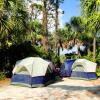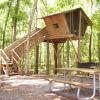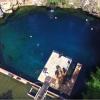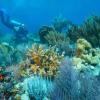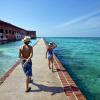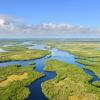A beach is a beach, right? Not in Florida. The Sunshine State has beach variety a-plenty. Depending on where you go, the beach sands will look dark, white or even orange! Here's your guide to Florida beach sands.
By David McRee
Sand is something I ordinarily try not to get on my feet, but the best way to walk on the beach is barefoot. The soft sand feels great, and there's nothing like kicking off my shoes to sink my toes into powdery-white, squeaky-clean beach sand. It's rejuvenating.
I grew up playing on the beaches of Anna Maria Island, where the sand was always brilliant white and soft. When I started exploring other beaches, I was surprised to find that there are many different types of beach sand in Florida-- and not all of them are white.
There have been many “contests” over the years to determine which beach has the whitest sand. White sand is wonderful, but I have no trouble appreciating beach sand of all kinds. I'm going to take you to some of my favorite beaches to have a look at the different types of beach sand that you may enjoy getting between your toes.
Where Did Florida Beach Sand Come From?
Much of the sand on Florida beaches is made up of quartz crystals, produced by the weathering of continental land masses like the Appalachian mountains. The quartz is washed down America's great rivers into the Atlantic and the Gulf of Mexico where it's carried onto the beaches by water currents and waves.
Combined with the sparkling quartz crystals may be shell fragments, coral limestone fossils and organic matter, which lend different colors to the sand. Beach sand along the southeast Florida coast and the Keys is often composed more of coral and mollusk shell fragments than of quartz crystals.
White Sand Beaches in Florida
Northwest Florida has some of the purest, whitest sand anywhere in the state. Its dazzling crystals are nearly pure quartz, resulting in soft fluffy sand that's a pleasure to walk on.
I'll never forget my first steps onto the white sand beach at St. Andrew's State Park near Panama City Beach. The sand was so pure and so soft. I dug my feet into it, scooped it up with my hands and marveled at its purity. Only a few tiny flecks of dark minerals could be seen in the nearly pure white sand. Other dazzling white Florida Panhandle beaches include:
Further south, the white sand beaches in Florida's peninsular Gulf coast begin just above Tampa Bay and extend south to Marco Island. Fine soft white quartz sand is found on the beaches around the Tampa Bay area, including the following well-known beaches:
Central and southwest Gulf coast beach sand is nearly as white as the white sand beaches in Florida's northwest, but is finer grained, somewhere between sugar and powder. In fact, in some spots on the white sandy beach, usually near the dunes, the sand is so clean it “squeaks” or “chirps” when you step on it in just the right way. This only happens with dry sand. It's quite entertaining for kids, especially big kids like me, to go scuffling through the dry powdery sand to make it squeak and chirp loudly. And white sand never seems to get hot even during the hottest days of summer.
Fort Myers Beach sand is considered excellent for sand sculpting. I attended the Annual American Sandsculpting Championship and Beach Festival. I learned from professional sand sculptor David Walker that the quartz sand grains on Fort Myers Beach are very angular, a characteristic of “younger” sand that helps the sand hold together well—a property much appreciated by the sand sculptors.
Gray and Black Sand Beaches in Florida
There are some special beaches in Venice that have black sand; not pure black but nearly so in some spots.
Black and dark brown fossil fragments are mixed in with the white quartz sand, creating a dark gray to almost black sand beach in Florida. The different shades of white and gray sand on Venice Beach are fascinating, and I especially enjoy taking a long walk on Caspersen Beach, just south of the Venice fishing pier.
Some of the fossils I always look for on Venice beaches are sharks' teeth. They come in all shapes and sizes, and are usually dark brown or black. I find a handful nearly every time I visit these unusual beaches.
Brown Sand Beaches
On many beaches, tiny fragments of shell are mixed in with the quartz crystals, making a colorful mix that may appear light brown or light gray. The shell and sand are smooth and polished from years of abrasion.
Walking long distances in this shelly sand can give your calves a real workout, especially down by the water's edge where your feet will sink deep into the wet sand. Southern Siesta Key on the state’s Gulf Coast near Turtle Beach, is a good spot to see this shelly sand. Many of the Atlantic coast beaches have brown sand.
Atlantic Beach Sand Diversity
Atlantic beaches seem to have a greater diversity of sand types than the Gulf beaches, and you'll find fewer beaches on the Atlantic with pure white sand. I think you'll enjoy the diversity of beach sand found all over Florida and will appreciate that a beach doesn't have to have white sand to be beautiful.
Cocoa Beach has a light gray-brown colored sand and is one of the most popular family vacation beaches in Florida. It is wonderful to walk on and every day you'll find people jogging, going for long walks, or carrying their surfboards down the wide, flat, sandy beaches of the Space Coast.
On Playalinda Beach, a short drive north of Kennedy Space Center, you'll find a steeper beach with tiny light brown shell fragments mixed in with the quartz crystals, resulting in sand that looks more brown. Sand with larger shell fragments just doesn't pack as firmly as sand with a larger percentage of quartz crystals.
Photographers will find it easier to take good photographs on the darker colored sands, because there's less contrast with the subject than on bright white beaches. Brown and gray sands don't produce as much glare from the sun, so they're easier on the eyes, too.
Orange Sand
The first time you see it you'll say “wow!” It really does look orange. Ormond Beach and Daytona Beach have sand that here and there in patches looks quite orange. It isn't the sand that is orange but the coquina shell fragments that have absorbed the rusty color of iron oxide.
Mixtures of Sand and Shell
Sand composition can vary greatly, even on beaches in the same area. Northern Siesta Key has sand that is nearly pure white quartz, while the southern part of the island has darker sand mixed with shell.
Even on a specific beach the sand can vary. Near the water, the grains may be larger and mixed with shell fragments, while near the dunes the sand will more likely be much finer-grained and lighter in color. At certain times of the year, depending on water currents and surf, some beaches—especially southwest coast beaches—have large piles of broken shell up to and just above the high tide line. This broken and worn shell refuse is referred to as “shell hash” and may be a foot or more deep. The shell can make walking with bare feet difficult. But even those beaches usually have soft sand a bit higher on the beach.
Solving the Problem of Sandy Feet
To get sand off your feet before you get into your car for the drive home: Sprinkle baby powder generously on sandy feet and legs. The sand will then brush off easily.
Of course, water works too. My dad used to bring a gallon of fresh water to the beach. He'd keep it in the trunk, and when we got into the car for the ride home, he would gently wash the sand off our feet with the warm water as we sat on the edge of the car seat and dangled our feet out of the door.
Next time you're at the beach in Florida, I hope you will take a closer look at the sand under your feet to see what it's made of.


